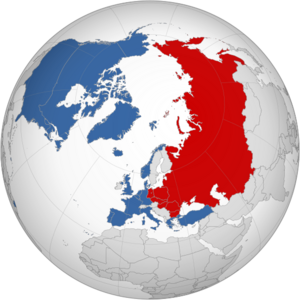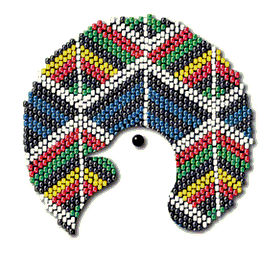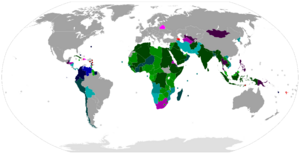Non-Aligned Movement facts for kids
Quick facts for kids
Non-Aligned Movement
|
|
|---|---|

Member States Observer States
|
|
| Coordinating Bureau | United Nations Headquarters New York City, New York |
| Membership |
|
| Leaders | |
|
• Principal decision-
making organ |
Conference of Heads of State or Government of Non-Aligned Countries |
|
• Chairmanship
|
|
|
• Chair
|
Yoweri Museveni, President of Uganda |
| Establishment | Belgrade, Yugoslavia 1 September 1961 as the Conference of Heads of State or Government of Non-Aligned Countries |
|
Website
https://nam.go.ug/ |
|
The Non-Aligned Movement (NAM) is a special group of 120 countries. These countries decided not to take sides with any of the major world powers. They wanted to protect their own interests, especially those of developing nations, during the Cold War. After the United Nations, NAM is the largest group of countries in the world.
The idea for NAM started after the Korean War. Some countries wanted to balance the power of the two main "teams" during the Cold War. One team was the pro-Soviet group, known for the Warsaw Pact. The other was the pro-American group, which included countries in NATO.
In 1961, the Non-Aligned Movement officially began in Belgrade, Yugoslavia. It was inspired by ideas from the Bandung Conference of 1955. Key leaders who helped start NAM were Josip Broz Tito (Yugoslavia), Jawaharlal Nehru (India), Gamal Abdel Nasser (Egypt), Kwame Nkrumah (Ghana), and Sukarno (Indonesia).
The main goal of NAM was to make sure its member countries had "national independence, sovereignty, and security." They wanted to fight against powerful nations trying to control others. This included opposing colonialism (when one country rules another) and racism.
Today, countries in the Non-Aligned Movement make up almost two-thirds of the United Nations members. They also represent 55% of the world's population. Most members are developing countries, but some are developed nations.
NAM was most active in the 1950s and 1960s. It helped countries gain independence from colonial rule. It also worked for disarmament (reducing weapons) and against apartheid in South Africa. Even after the Cold War ended in 1991, NAM continued its work. Now, it focuses on helping developing nations work together, especially those in the Global South.
Contents
How the Non-Aligned Movement Started
Early Days and the Cold War
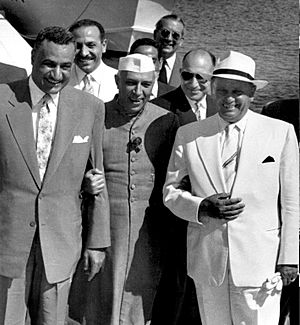
The term "Non-Alignment" was first used in 1950 by India and Yugoslavia at the United Nations. Both countries did not want to join either side during the Korean War.
The idea of NAM grew from principles agreed upon at the Bandung Conference in 1955. The organization was officially formed on the Brijuni islands in Yugoslavia in 1956. Leaders like Josip Broz Tito (Yugoslavia), Jawaharlal Nehru (India), and Gamal Abdel Nasser (Egypt) signed the Declaration of Brijuni on July 19, 1956.
One important quote from the Declaration is: "Peace cannot be achieved with separation. It needs collective security and freedom for all, ending one country's control over another." Leaders like Nehru wanted to protect their newly independent countries. They faced a difficult world where two superpowers demanded loyalty.
The Movement aimed to offer a middle path for developing countries during the Cold War. This was between the Western Bloc (led by the US) and the Eastern Bloc (led by the Soviet Union).
The term "non-alignment" became the name for countries attending the Conference of Heads of State or Government of Non-Aligned Countries. The first conference was held in 1961.
Five Principles for Peace
In 1954, Indian Prime Minister Nehru and Chinese Premier Zhou Enlai described the Five Principles of Peaceful Coexistence. These principles, called Panchsheel, guided relations between China and India. They later became the foundation for the Non-Aligned Movement.
The five principles were:
- Respect for each other's territorial integrity (borders) and sovereignty (right to govern themselves).
- Not attacking each other.
- Not interfering in each other's internal affairs.
- Treating each other as equals and for mutual benefit.
- Living together peacefully.
A big step for NAM was the 1955 Bandung Conference. This meeting of Asian and African states was hosted by Indonesian President Sukarno. Leaders like Sukarno, Nasser, Nehru, and Tito attended. The conference adopted a "declaration on promoting world peace and cooperation." This included the five principles and a promise to stay neutral in the Cold War.
Six years later, in September 1961, the first Conference of Heads of State or Government of Non-Aligned Countries was held in Belgrade. The name "non-aligned movement" was first used at the fifth conference in 1976.
At the Lusaka Conference in 1970, members added new goals. These included solving disagreements peacefully and avoiding military alliances with big powers. They also opposed having military bases in other countries.
Cuba's Role in the 1970s
In the 1970s, Cuba tried to become a leader in the Non-Aligned Movement. It sent military advisors and helped with economic and social programs in other countries. At the 1976 conference, NAM praised Cuba's help in Angola against South Africa's government.
The next conference was planned for Havana in 1979. Fidel Castro of Cuba was set to lead it. This conference in September 1979 was a high point for Cuba's influence. Most countries believed Cuba was not aligned with the Soviet Union.
However, in December 1979, the Soviet Union sent troops into Afghanistan. Afghanistan was also a NAM member. At the United Nations, NAM members voted to condemn the Soviet Union. But Cuba voted against this, supporting the USSR. This made Cuba lose its leadership role and reputation in NAM. The Movement was divided over the Soviet-Afghan War.
After the Cold War

When the Cold War ended, the Non-Aligned Movement changed. The breakup of Yugoslavia in 1991–1992 also affected it. Yugoslavia was a founding member, but its membership was suspended. Most of the new countries formed from Yugoslavia are now observers. India, another founding member, also reduced its focus on the Movement.
In 2004, Malta and Cyprus left NAM when they joined the European Union. Azerbaijan and Fiji joined in 2011. Azerbaijan and Belarus are the only European members of NAM.
Since the Cold War, NAM has had to find a new purpose. It still believes in national independence and fighting against control by powerful nations. Now, it also focuses on helping developing countries work together. It wants to give them a stronger voice in international discussions.
The Movement believes that the world's poorest nations are still being treated unfairly. It now opposes Western control and new forms of colonialism. NAM also focuses on economic problems like poverty and unfair trade. It sees these as threats to peace and security.
The 16th NAM summit was held in Tehran, Iran, in 2012. Iran took over as Chair of the Movement until 2015. Venezuela hosted the 17th summit in 2016. Azerbaijan hosted the 18th summit in 2019. Uganda hosted the 19th summit in January 2024 and is the current Chair.
How the Non-Aligned Movement Works
The Non-Aligned Movement does not have a very strict structure. This is because its main goal is not to be part of a big military group. Some basic rules were set in the 1996 Cartagena Document on Methodology.
The "Summit Conference of Heads of State or Government of Non-Aligned States" is the highest decision-making body. The leadership of the Movement rotates among countries. It changes at each summit to the country hosting the meeting.
To become a member of NAM, a country must follow the ten "Bandung principles" from 1955. These principles are similar to the beliefs of the United Nations:
- Respect for human rights and the goals of the Charter of the United Nations.
- Respect for the independence and borders of all nations.
- Supporting movements for national independence.
- Believing all races and nations, big or small, are equal.
- Not interfering in other countries' internal affairs.
- Respecting each nation's right to defend itself.
- Not threatening or using force against any country's independence.
- Solving all international problems peacefully.
- Promoting shared interests and cooperation.
- Respecting justice and international duties.
What the Non-Aligned Movement Believes In
NAM has had many different leaders, from various political backgrounds. But they are all united by their commitment to world peace and security. At a summit in 1983, the Movement called itself "history's biggest peace movement." NAM also strongly supports disarmament (reducing weapons).
NAM believes in cooperation, especially when it benefits everyone. Most NAM members are also part of the United Nations. Both groups aim for peaceful cooperation. NAM has played a big role in fighting against unfair governments, like the apartheid system in South Africa. It also supported groups fighting for freedom in different places.
Current Work and Views
Changing the UN Security Council
NAM has openly criticized how the UN currently works. It wants to change the United Nations Security Council. NAM says that powerful countries have used the UN in ways that go against NAM's principles.
NAM has suggested ways to give "non-aligned" states more power and representation. These proposed changes aim to make UN decisions more open and democratic. NAM sees the UN Security Council as the part most in need of reform.
Supporting Self-Determination
Since 1961, NAM has supported discussions about Puerto Rico's right to self-determination at the United Nations. It has also supported the discussion of Western Sahara's self-determination since 1973. NAM supports the Sahrawi people choosing their own future.
Working for Sustainable Development
NAM is committed to sustainable development and reaching the Millennium Development Goals. However, it believes that the international community has not created good conditions for development. It feels that countries' right to develop themselves has been limited.
Problems like globalization, debt, unfair trade, and lack of democracy in global financial decisions are seen as barriers to development.
South-South Cooperation
The Non-Aligned Movement Centre for South-South Technical Cooperation (NAM CSSTC) is an important part of NAM's efforts. It helps developing countries improve their skills and become more self-reliant.
The NAM CSSTC is located in Jakarta, Indonesia. It focuses on technical cooperation between countries in the Global South. Other NAM centers focus on health, human rights, and technology.
The NAM CSSTC was set up after the Cold War to help developing countries grow. Its goal is to help these countries achieve sustainable human development. It also aims for developing countries to be equal partners in international relations.
The NAM CSSTC works with training centers and experts in NAM member countries. For example, it has held workshops on stopping illegal fishing. It has also sent agricultural experts to Myanmar and offered training in tissue culture.
Summits of the Non-Aligned Movement

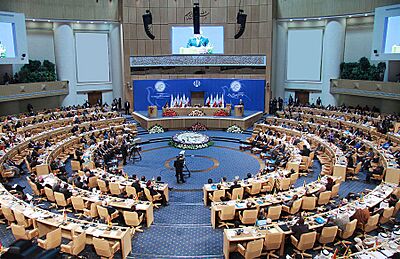
The Conference of Heads of State or Government of the Non-Aligned Countries, also called the Non-Aligned Movement Summit, is the main meeting for the Movement. These summits are held every few years:
| Date | Host country | Host city | Slogan | |
|---|---|---|---|---|
| 1st | 1–6 September 1961 | Belgrade | ||
| 2nd | 5–10 October 1964 | Cairo | ||
| 3rd | 8–10 September 1970 | Lusaka | ||
| 4th | 5–9 September 1973 | Algiers | ||
| 5th | 16–19 August 1976 | Colombo | ||
| 6th | 3–9 September 1979 | Havana | ||
| 7th | 7–12 March 1983 | New Delhi | ||
| 8th | 1–6 September 1986 | Harare | ||
| 9th | 4–7 September 1989 | Belgrade | ||
| 10th | 1–6 September 1992 | Jakarta | ||
| 11th | 18–20 October 1995 | Cartagena | ||
| 12th | 2–3 September 1998 | Durban | ||
| 13th | 20–25 February 2003 | Kuala Lumpur | ||
| 14th | 15–16 September 2006 | Havana | ||
| 15th | 11–16 July 2009 | Sharm el-Sheikh | International Solidarity for Peace and Development | |
| 16th | 26–31 August 2012 | Tehran | Lasting peace through joint global governance | |
| 17th | 13–18 September 2016 | Porlamar | Peace, Sovereignty and Solidarity for Development | |
| 18th | 25–26 October 2019 | Baku | Upholding the Bandung principles to ensure a concerted and adequate response to the challenges of the contemporary world | |
| 19th | 15-20 January 2024 | Kampala | Deepening Cooperation for Shared Global Affluence |
Many other meetings are held between the summits. These include meetings of foreign ministers every three years.
The 7th Summit was originally planned for Baghdad, Iraq, in 1982. But during the Iran–Iraq War, Iran tried to show that Baghdad's airspace was not safe. This, along with threats, led to the summit being moved to New Delhi in 1983.
NAM celebrated its 50th anniversary in Belgrade in 2011. In May 2020, an online summit called "United Against Covid-19" was held. It focused on the global fight against the COVID-19 pandemic. NAM also celebrated its 60th anniversary in Belgrade in 2021.
Leaders of the Non-Aligned Movement
A new leader, called the Chair, is chosen at each summit meeting. The Coordinating Bureau, located at the UN, helps guide the Movement's work.
| Image | Chair | Country (holding the Presidency) | Party | From | To |
|---|---|---|---|---|---|
 |
Josip Broz Tito (1892–1980) | League of Communists of Yugoslavia | 1961 | 1964 | |
 |
Gamal Abdel Nasser (1918–1970) | Arab Socialist Union | 1964 | 1970 | |
 |
Kenneth Kaunda (1924–2021) | United National Independence Party | 1970 | 1973 | |
 |
Houari Boumediène (1932–1978) | Revolutionary Council | 1973 | 1976 | |
 |
William Gopallawa (1896–1981) | Independent | 1976 | 1978 | |
 |
Junius Richard Jayewardene (1906–1996) | United National Party | 1978 | 1979 | |
 |
Fidel Castro (1926–2016) | Communist Party of Cuba | 1979 | 1983 | |
 |
Neelam Sanjiva Reddy (1913–1996) | Janata Party | 1983 | ||
 |
Zail Singh (1916–1994) | Indian National Congress | 1983 | 1986 | |
 |
Robert Mugabe (1924–2019) | ZANU-PF | 1986 | 1989 | |
 |
Janez Drnovšek (1950–2008) | League of Communists of Yugoslavia | 1989 | 1990 | |
 |
Borisav Jović (1928–2021) | Socialist Party of Serbia | 1990 | 1991 | |
 |
Stjepan Mesić (born 1934) | Croatian Democratic Union | 1991 | ||
 |
Branko Kostić (1939–2020) | Democratic Party of Socialists of Montenegro | 1991 | 1992 | |
 |
Dobrica Ćosić (1921–2014) | Independent | 1992 | ||
 |
Suharto (1921–2008) | Golkar | 1992 | 1995 | |
 |
Ernesto Samper (born 1950) | Colombian Liberal Party | 1995 | 1998 | |
 |
Andrés Pastrana Arango (born 1954) | Colombian Conservative Party | 1998 | ||
 |
Nelson Mandela (1918–2013) | African National Congress | 1998 | 1999 | |
 |
Thabo Mbeki (born 1942) | 1999 | 2003 | ||
 |
Mahathir Mohamad (born 1925) | United Malays National Organisation | 2003 | ||
 |
Abdullah Ahmad Badawi (born 1939) | 2003 | 2006 | ||
 |
Fidel Castro (1926–2016) | Communist Party of Cuba | 2006 | 2008 | |
 |
Raúl Castro (born 1931) | 2008 | 2009 | ||
 |
Hosni Mubarak (1928–2020) | National Democratic Party | 2009 | 2011 | |
 |
Mohamed Hussein Tantawi (1935–2021) | Independent | 2011 | 2012 | |
 |
Mohamed Morsi (1951–2019) | Freedom and Justice Party | 2012 | ||
 |
Mahmoud Ahmadinejad (born 1956) | Alliance of Builders of Islamic Iran | 2012 | 2013 | |
 |
Hassan Rouhani (born 1948) | Moderation and Development Party | 2013 | 2016 | |
 |
Nicolás Maduro (born 1962) | United Socialist Party | 2016 | 2019 | |
 |
Ilham Aliyev (born 1961) | New Azerbaijan Party | 2019 | 2024 | |
 |
Yoweri Museveni (born 1944) | National Resistance Movement | 2024 | Incumbent | |
Members, Observers, and Guests
Current Members
The following countries are members of the Non-Aligned Movement, listed by continent and their year of joining:
Africa
Almost every country in Africa (except South Sudan) is a member of the Non-Aligned Movement.
 Algeria (1961)
Algeria (1961) Angola (1976)
Angola (1976) Benin (1964)
Benin (1964) Botswana (1970)
Botswana (1970) Burkina Faso (1973)
Burkina Faso (1973) Burundi (1964)
Burundi (1964) Cameroon (1964)
Cameroon (1964) Cape Verde (1976)
Cape Verde (1976) Central African Republic (1964)
Central African Republic (1964) Chad (1964)
Chad (1964) Comoros (1976)
Comoros (1976) Democratic Republic of the Congo (1961)
Democratic Republic of the Congo (1961) Djibouti (1983)
Djibouti (1983) Egypt (1961)
Egypt (1961) Equatorial Guinea (1970)
Equatorial Guinea (1970) Eritrea (1995)
Eritrea (1995) Eswatini (1970)
Eswatini (1970) Ethiopia (1961)
Ethiopia (1961) Gabon (1970)
Gabon (1970) Gambia (1973)
Gambia (1973) Ghana (1961)
Ghana (1961) Guinea (1961)
Guinea (1961) Guinea-Bissau (1976)
Guinea-Bissau (1976) Ivory Coast (1973)
Ivory Coast (1973) Kenya (1964)
Kenya (1964) Lesotho (1970)
Lesotho (1970) Liberia (1964)
Liberia (1964) Libya (1964)
Libya (1964) Madagascar (1973)
Madagascar (1973) Malawi (1964)
Malawi (1964) Mali (1961)
Mali (1961) Mauritania (1964)
Mauritania (1964) Mauritius (1973)
Mauritius (1973) Morocco (1961)
Morocco (1961) Mozambique (1976)
Mozambique (1976) Namibia (1979)
Namibia (1979) Niger (1973)
Niger (1973) Nigeria (1964)
Nigeria (1964) Republic of the Congo (1964)
Republic of the Congo (1964) Rwanda (1970)
Rwanda (1970) São Tomé and Príncipe (1976)
São Tomé and Príncipe (1976) Senegal (1964)
Senegal (1964) Seychelles (1976)
Seychelles (1976) Sierra Leone (1964)
Sierra Leone (1964) Somalia (1961)
Somalia (1961) South Africa (1994)
South Africa (1994) Sudan (1961)
Sudan (1961) Tanzania (1964)
Tanzania (1964) Togo (1964)
Togo (1964) Tunisia (1961)
Tunisia (1961) Uganda (1964)
Uganda (1964) Zambia (1964)
Zambia (1964) Zimbabwe (1979)
Zimbabwe (1979)
Americas
 Antigua and Barbuda (2006)
Antigua and Barbuda (2006) Bahamas (1983)
Bahamas (1983) Barbados (1983)
Barbados (1983) Belize (1981)
Belize (1981) Bolivia (1979)
Bolivia (1979) Chile (1971)
Chile (1971) Colombia (1983)
Colombia (1983) Cuba (1961)
Cuba (1961) Dominica (2006)
Dominica (2006) Dominican Republic (2000)
Dominican Republic (2000) Ecuador (1983)
Ecuador (1983) Grenada (1979)
Grenada (1979) Guatemala (1993)
Guatemala (1993) Guyana (1970)
Guyana (1970) Haiti (2006)
Haiti (2006) Honduras (1995)
Honduras (1995) Jamaica (1970)
Jamaica (1970) Nicaragua (1979)
Nicaragua (1979) Panama (1976)
Panama (1976) Peru (1973)
Peru (1973) Saint Kitts and Nevis (2006)
Saint Kitts and Nevis (2006) Saint Lucia (1983)
Saint Lucia (1983) Saint Vincent and the Grenadines (2003)
Saint Vincent and the Grenadines (2003) Suriname (1983)
Suriname (1983) Trinidad and Tobago (1970)
Trinidad and Tobago (1970) Venezuela (1989)
Venezuela (1989)
Asia
 /
/ Afghanistan (1961)
Afghanistan (1961) Bahrain (1973)
Bahrain (1973) Bangladesh (1973)
Bangladesh (1973) Bhutan (1973)
Bhutan (1973) Brunei Darussalam (1993)
Brunei Darussalam (1993) Cambodia (1961)
Cambodia (1961) India (1961)
India (1961) Indonesia (1961)
Indonesia (1961) Iran (1979)
Iran (1979) Iraq (1961)
Iraq (1961) Jordan (1964)
Jordan (1964) Kuwait (1964)
Kuwait (1964) Laos (1964)
Laos (1964) Lebanon (1961)
Lebanon (1961) Malaysia (1970)
Malaysia (1970) Maldives (1976)
Maldives (1976) Mongolia (1993)
Mongolia (1993) Myanmar (1961)
Myanmar (1961) Nepal (1961)
Nepal (1961) North Korea (1975)
North Korea (1975) Oman (1973)
Oman (1973) Pakistan (1979)
Pakistan (1979) Palestine (1976)
Palestine (1976) Philippines (1993)
Philippines (1993) Qatar (1973)
Qatar (1973) Saudi Arabia (1961)
Saudi Arabia (1961) Singapore (1970)
Singapore (1970) Sri Lanka (1961)
Sri Lanka (1961) Syria (1964)
Syria (1964) Thailand (1993)
Thailand (1993) East Timor (2003)
East Timor (2003) Turkmenistan (1995)
Turkmenistan (1995) United Arab Emirates (1970)
United Arab Emirates (1970) Uzbekistan (1993)
Uzbekistan (1993) Vietnam (1976)
Vietnam (1976) Yemen (1990)
Yemen (1990)
Europe
 Azerbaijan (2011)
Azerbaijan (2011) Belarus (1998)
Belarus (1998)
Oceania
 Fiji (2011)
Fiji (2011) Papua New Guinea (1993)
Papua New Guinea (1993) Vanuatu (1983)
Vanuatu (1983)
Former Members
 North Yemen (1961–1990)
North Yemen (1961–1990) Cyprus (1961–2004)
Cyprus (1961–2004) Yugoslavia (1961–1992)
Yugoslavia (1961–1992) South Yemen (1970–1990)
South Yemen (1970–1990) Malta (1992–2004)
Malta (1992–2004) Argentina (1973–1991)
Argentina (1973–1991)
Observers
The following countries and groups have observer status, meaning they can attend meetings but not vote:
Countries
Organisations
- Association of Southeast Asian Nations
- African Union
- Afro-Asian People's Solidarity Organisation
- Arab League
- Commonwealth Secretariat
- Hostosian National Independence Movement
- Kanak and Socialist National Liberation Front
- Organisation of Islamic Cooperation
- South Centre
- United Nations
- World Peace Council
Former Observers
 Vatican City (1970)
Vatican City (1970)
Guests
There is no permanent guest status. However, non-member countries and many organizations are often invited as guests to conferences.
See also
 In Spanish: Movimiento de Países No Alineados para niños
In Spanish: Movimiento de Países No Alineados para niños
- Asian–African Conference
- BRICS
- Five Principles of Peaceful Coexistence
- G-77
- India and the Non-Aligned Movement
- Neutral country
- South-South Cooperation
- Third World
- United Nations Conference on Trade and Development
- Yugoslavia and the Non-Aligned Movement


